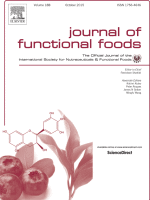Daikon
How to submit an article:
- Registered users can submit any published journal article that has a unique DOI (Digital Object Identifier) name or link to Research Hub.
- For example, you can paste the full DOI link:
https://doi.org/10.1109/5.771073or just the DOI name:10.1109/5.771073into the field above and click submit. - The person who is first to submit a valid article to Research Hub will forever be credited for it, and every article submission earns you +6 Research Points.
Related Topics
Published research studies are articles that present the findings of original research that has undergone a peer-review process and has been made publicly available in scholarly journals, books or other media.

Deciphering the Nutraceutical Potential of Raphanus sativus—A Comprehensive Overview
2019 Feb 14 Nutrients Abinaya ManivannanOrcID,Jin-Hee Kim,Do-Sun Kim,Eun-Su Lee andHye-Eun Lee
Systematic Review DaikonBioactive compounds present in different parts of radishes, such as leaves, sprouts, stem and roots, act on a variety of potential drug targets associated with ailments, such as cancer, inflammation, liver injury and diabetes.

Sulforaphene identified from radish (Raphanus sativus L.) seeds possesses antimicrobial properties against multidrug-resistant bacteria and methicillin-resistant Staphylococcus aureus
2016 Jun Journal of Functional Foods Sooyeon Li, Sang-Wook Han, Jongkee Kim
DaikonStrong bactericidal activity was exhibited by sulforaphene against all strains of Helicobacter pylori.
Research insights are moderated by the Research Hub team and offer an at-a-glance overview of interesting research findings.

2019 Nutrients
Bioactive compounds present in different parts of radishes, such as leaves, sprouts, stem and roots, act on a variety of potential drug targets associated with ailments, such as cancer, inflammation, liver injury and diabetes.
Systematic Review
Deciphering the Nutraceutical Potential of Raphanus sativus—A Comprehensive Overview
Abinaya ManivannanOrcID,Jin-Hee Kim,Do-Sun Kim,Eun-Su Lee andHye-Eun Lee

2016 Journal of Functional Foods
Strong bactericidal activity was exhibited by sulforaphene against all strains of Helicobacter pylori.
Sulforaphene identified from radish (Raphanus sativus L.) seeds possesses antimicrobial properties against multidrug-resistant bacteria and methicillin-resistant Staphylococcus aureus
Sooyeon Li, Sang-Wook Han, Jongkee Kim
Review Articles
Review articles summarise and critically evaluate the current state of research on a specific topic or field by synthesising multiple primary research studies.
Clinical Trials
Clinical trials are research studies that involve people and are conducted to evaluate the safety and efficacy of new treatments or interventions, such as drugs, medical devices, or behavioural therapies.
Study Protocols
Published study protocols are detailed plans that outline the objectives, methodology, statistical analyses, and organisation of a research study that have been made publicly available for others to review and use as a reference.
Presentation Slides

Systematic Review
Bioactive compounds present in different parts of radishes, such as leaves, sprouts, stem and roots, act on a variety of potential drug targets associated with ailments, such as cancer, inflammation, liver injury and diabetes.
Abinaya ManivannanOrcID,Jin-Hee Kim,Do-Sun Kim,Eun-Su Lee andHye-Eun Lee

Strong bactericidal activity was exhibited by sulforaphene against all strains of Helicobacter pylori.
Sooyeon Li, Sang-Wook Han, Jongkee Kim
Executive Summary
Write an executive summary in the form of a blog article on the topic of "Research into Chinese medicine treatment for Daikon" summarising the research below and using language that can be easily understood by patients and avoiding medical jargon using a professional and caring tone of voice.
Write an executive summary in the form of a blog article on the topic of "Researched Chinese medicine treatments for Daikon" summarising the research below in an objective and easy to understand way, and using language that can be easily understood by patients. Group the article into Chinese medicine treatments first, followed by nutrition and other treatments. Avoid using medical jargon and use a professional and caring tone of voice.
Write me a concise but easy to understand executive summary on the topic of "Chinese medicine treatments for Daikon" based on the following research that I will give you. Your summary should be 2 paragraphs long in Australian English spelling and include references to the studies.
A Systematic Review published in 2019 in the journal Nutrients found that Bioactive compounds present in different parts of radishes, such as leaves, sprouts, stem and roots, act on a variety of potential drug targets associated with ailments, such as cancer, inflammation, liver injury and diabetes. Radishes is of great pharmaceutical importance, most of which has been attributed to its antioxidant property. The administration of radish extracts under numerous pathological conditions aids in the recovery of diseases and in the prevention of harmful ailments because of their attributed bioactivities. Bioactive compounds present in different parts of radishes, such as leaves, sprouts, stem and roots, act on a variety of potential drug targets associated with ailments, such as cancer, inflammation, liver injury and diabetes. However, the in-depth molecular mechanistic studies are required to address the regulatory roles of bioactive compounds in radish extracts. In future, researches focusing on the determination and pharmacokinetic elucidation of the bioactive compounds in radishes could facilitate the designing of plant based drugs for life threatening disorders, such as cancer and diabetes. Overall, the knowledge gained from the present researches in radish should be utilized in the discovery of novel drug molecules with higher efficacy towards drug targeting with less side effects.
A published in 2016 in the journal Journal of Functional Foods found that Strong bactericidal activity was exhibited by sulforaphene against all strains of Helicobacter pylori. Sulforaphene (SFE), one of the major ITCs in radish seeds, specifically exhibited a strong effect against the multidrug-resistant H. pylori strain 212 with a MIC90 (0.6 µg/mL). Methicillin-resistant Staphylococcus aureus was also susceptible to SFE treatment, with MIC90 values of 12.5–25.0 µg/mL, but not methicillin-susceptible S. aureus. This observation gives new insight into the potential of SFE as a medicinal resource in foods and has implications in the development of new functional antimicrobial agents.
Moderation Tools
Topic
Sign In
Users not signed in are limited to viewing the 5 most recent items of content.
Need to find full article — 31 Aug 2021